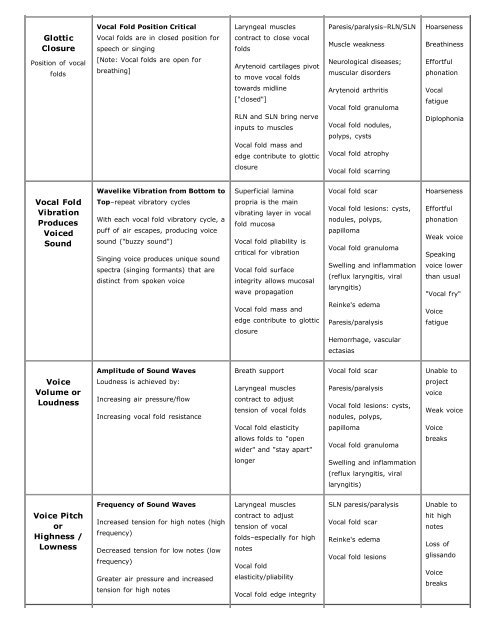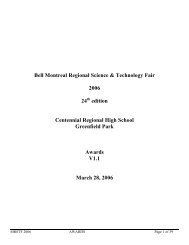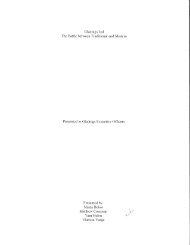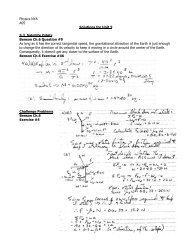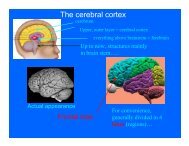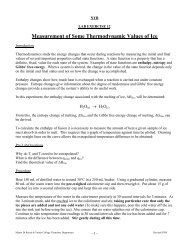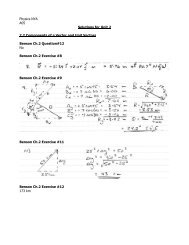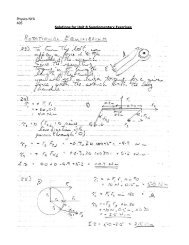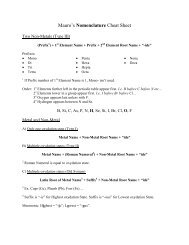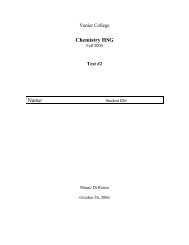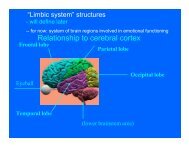anatomy & physiology of voice production
anatomy & physiology of voice production
anatomy & physiology of voice production
Create successful ePaper yourself
Turn your PDF publications into a flip-book with our unique Google optimized e-Paper software.
Glottic<br />
Closure<br />
Position <strong>of</strong> vocal<br />
folds<br />
Vocal Fold<br />
Vibration<br />
Produces<br />
Voiced<br />
Sound<br />
Voice<br />
Volume or<br />
Loudness<br />
Voice Pitch<br />
or<br />
Highness /<br />
Lowness<br />
Vocal Fold Position Critical<br />
Vocal folds are in closed position for<br />
speech or singing<br />
[Note: Vocal folds are open for<br />
breathing]<br />
Wavelike Vibration from Bottom to<br />
Top–repeat vibratory cycles<br />
With each vocal fold vibratory cycle, a<br />
puff <strong>of</strong> air escapes, producing <strong>voice</strong><br />
sound ("buzzy sound")<br />
Singing <strong>voice</strong> produces unique sound<br />
spectra (singing formants) that are<br />
distinct from spoken <strong>voice</strong><br />
Amplitude <strong>of</strong> Sound Waves<br />
Loudness is achieved by:<br />
Increasing air pressure/flow<br />
Increasing vocal fold resistance<br />
Frequency <strong>of</strong> Sound Waves<br />
Increased tension for high notes (high<br />
frequency)<br />
Decreased tension for low notes (low<br />
frequency)<br />
Greater air pressure and increased<br />
tension for high notes<br />
Laryngeal muscles<br />
contract to close vocal<br />
folds<br />
Arytenoid cartilages pivot<br />
to move vocal folds<br />
towards midline<br />
["closed"]<br />
RLN and SLN bring nerve<br />
inputs to muscles<br />
Vocal fold mass and<br />
edge contribute to glottic<br />
closure<br />
Superficial lamina<br />
propria is the main<br />
vibrating layer in vocal<br />
fold mucosa<br />
Vocal fold pliability is<br />
critical for vibration<br />
Vocal fold surface<br />
integrity allows mucosal<br />
wave propagation<br />
Vocal fold mass and<br />
edge contribute to glottic<br />
closure<br />
Breath support<br />
Laryngeal muscles<br />
contract to adjust<br />
tension <strong>of</strong> vocal folds<br />
Vocal fold elasticity<br />
allows folds to "open<br />
wider" and "stay apart"<br />
longer<br />
Laryngeal muscles<br />
contract to adjust<br />
tension <strong>of</strong> vocal<br />
folds–especially for high<br />
notes<br />
Vocal fold<br />
elasticity/pliability<br />
Vocal fold edge integrity<br />
Paresis/paralysis–RLN/SLN<br />
Muscle weakness<br />
Neurological diseases;<br />
muscular disorders<br />
Arytenoid arthritis<br />
Vocal fold granuloma<br />
Vocal fold nodules,<br />
polyps, cysts<br />
Vocal fold atrophy<br />
Vocal fold scarring<br />
Vocal fold scar<br />
Vocal fold lesions: cysts,<br />
nodules, polyps,<br />
papilloma<br />
Vocal fold granuloma<br />
Swelling and inflammation<br />
(reflux laryngitis, viral<br />
laryngitis)<br />
Reinke's edema<br />
Paresis/paralysis<br />
Hemorrhage, vascular<br />
ectasias<br />
Vocal fold scar<br />
Paresis/paralysis<br />
Vocal fold lesions: cysts,<br />
nodules, polyps,<br />
papilloma<br />
Vocal fold granuloma<br />
Swelling and inflammation<br />
(reflux laryngitis, viral<br />
laryngitis)<br />
SLN paresis/paralysis<br />
Vocal fold scar<br />
Reinke's edema<br />
Vocal fold lesions<br />
Hoarseness<br />
Breathiness<br />
Effortful<br />
phonation<br />
Vocal<br />
fatigue<br />
Diplophonia<br />
Hoarseness<br />
Effortful<br />
phonation<br />
Weak <strong>voice</strong><br />
Speaking<br />
<strong>voice</strong> lower<br />
than usual<br />
"Vocal fry"<br />
Voice<br />
fatigue<br />
Unable to<br />
project<br />
<strong>voice</strong><br />
Weak <strong>voice</strong><br />
Voice<br />
breaks<br />
Unable to<br />
hit high<br />
notes<br />
Loss <strong>of</strong><br />
glissando<br />
Voice<br />
breaks


